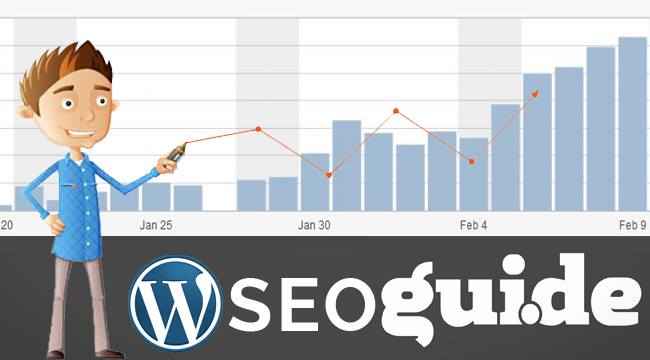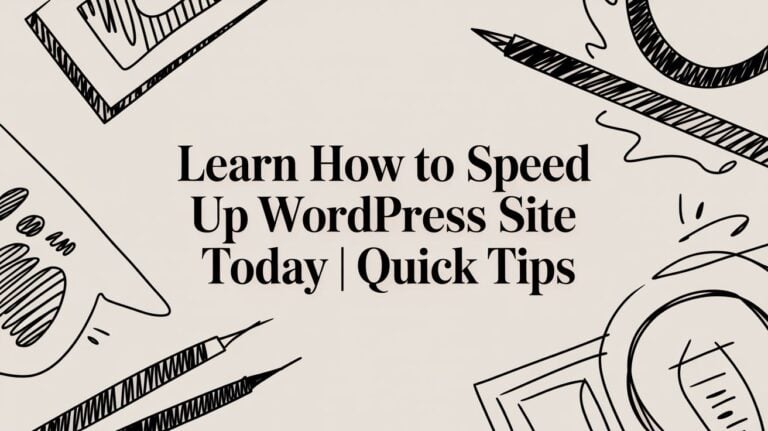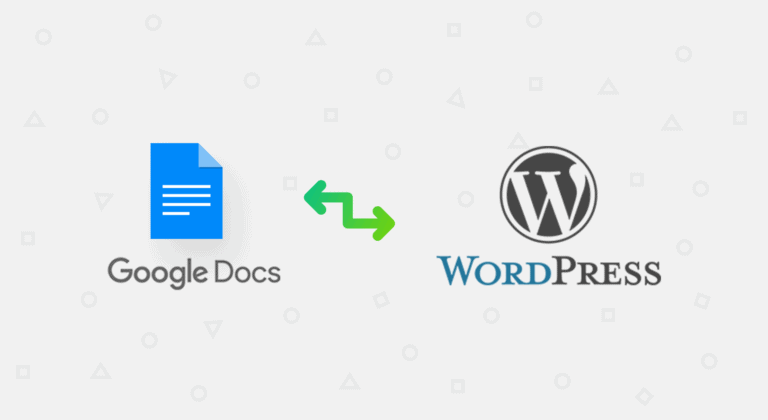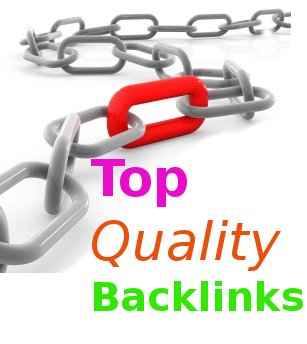10 WordPress SEO Best Practices for Top Rankings in 2025
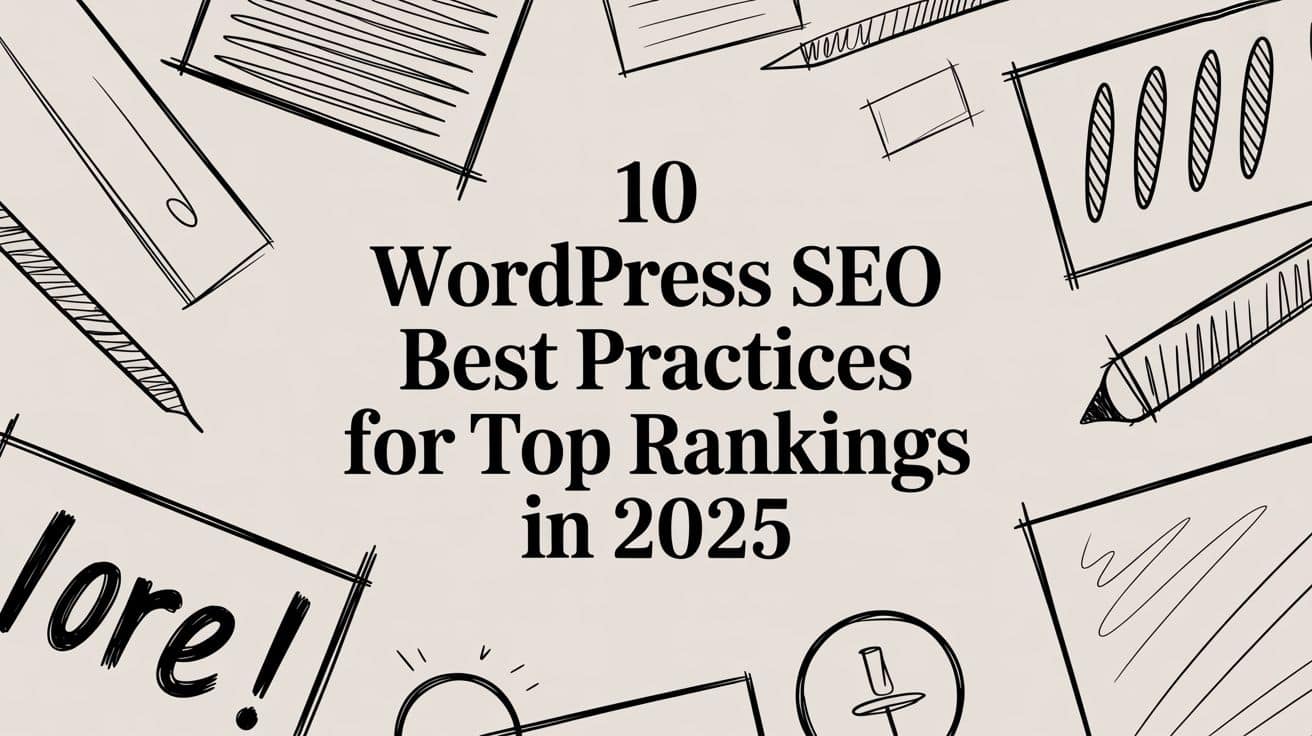
WordPress powers over 43% of the web, making it a dominant force for creators and businesses alike. Yet, simply having a WordPress site is no guarantee of search engine visibility. To truly succeed, you need to move beyond the default installation and implement a robust strategy focused on search engine optimization. This comprehensive guide provides a definitive blueprint for mastering the most essential WordPress SEO best practices.
This isn't a list of vague suggestions. Instead, you will find a detailed, actionable roundup of the ten most impactful optimizations you can make today. We will cover the entire spectrum of SEO, from foundational technical setups like configuring the right plugins and optimizing permalink structures, to advanced tactics such as implementing schema markup and improving Core Web Vitals. Each point is designed to be a practical mini-guide, giving you the specific steps needed to enhance your site's performance and climb Google's rankings.
Whether you're a small business owner, a dedicated blogger, or a digital marketer, these proven techniques are critical for driving sustainable organic traffic. We’ll explore how to properly structure your content with heading tags, optimize images for speed and context, and ensure your site is both secure with HTTPS and fully mobile-responsive. By applying these WordPress SEO best practices, you will build a stronger, faster, and more visible website prepared to compete for top search positions and connect with your target audience more effectively. Let's begin building your framework for lasting SEO success.
1. Install and Configure an SEO Plugin (Yoast SEO or Rank Math)
One of the most crucial foundational steps for implementing WordPress SEO best practices is installing a comprehensive SEO plugin. Tools like Yoast SEO or Rank Math act as your all-in-one command center for on-page and technical SEO, transforming complex optimization tasks into a user-friendly interface directly within your WordPress dashboard. Instead of manually editing code to add meta titles, descriptions, or schema markup, these plugins provide intuitive fields for you to fill out on every page and post.
They handle critical background tasks such as generating XML sitemaps for search engine crawlers, controlling indexing rules through robots.txt and meta tags, and implementing breadcrumbs for improved site navigation and user experience. This automation is indispensable, allowing you to focus on creating high-quality content rather than getting bogged down in technical configurations.
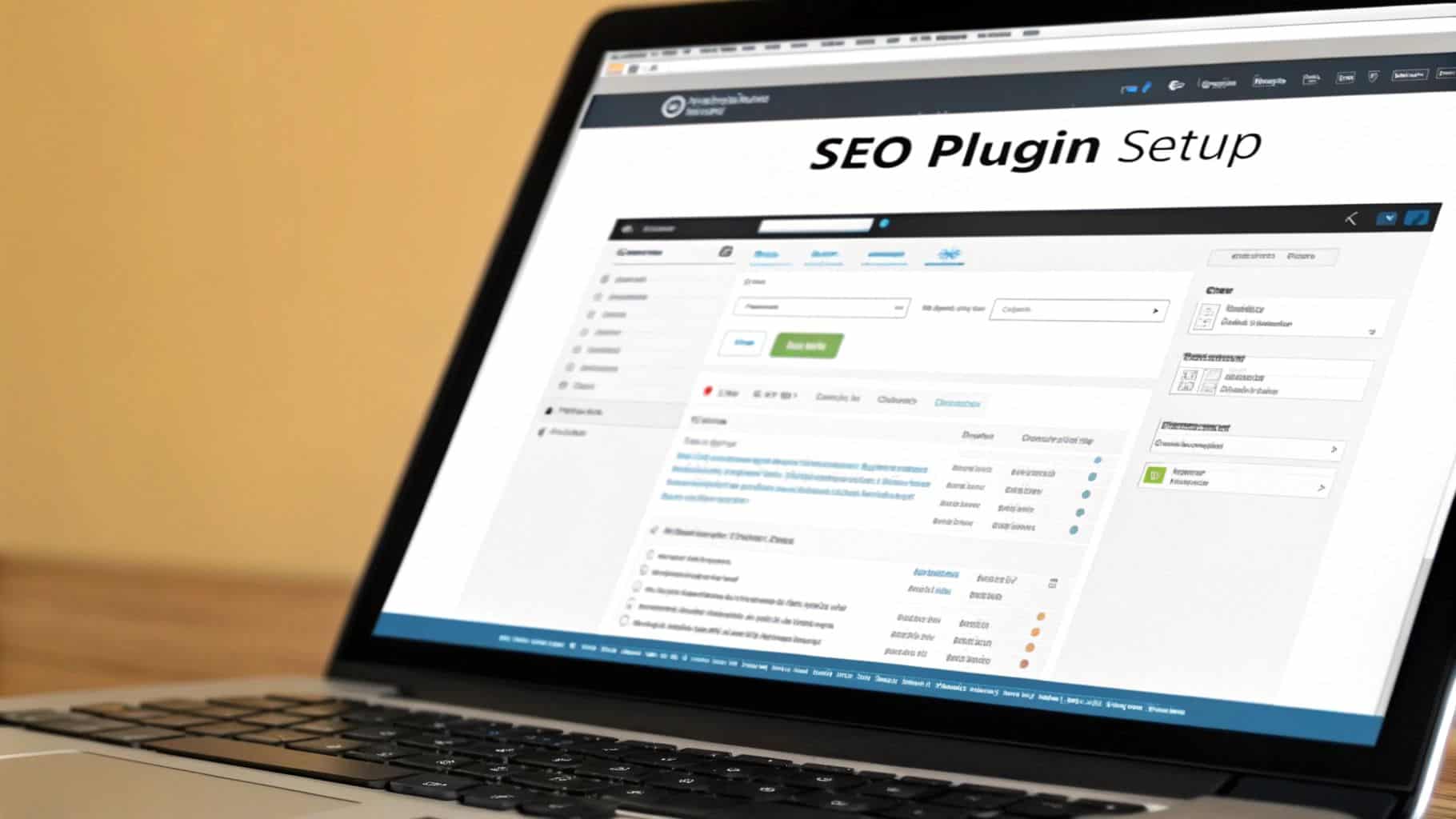
Why This Is a Foundational Step
Think of an SEO plugin as a framework that empowers all your other optimization efforts. High-traffic sites like WPBeginner leverage Rank Math to manage their extensive content library, while The Wirecutter relies on Yoast SEO's robust features to optimize thousands of product review pages. Without a plugin, managing SEO at this scale would be nearly impossible.
Key Insight: An SEO plugin doesn't automatically optimize your site. It is a powerful toolset that simplifies the implementation of SEO strategies, making best practices accessible to everyone from beginners to experts.
Actionable Tips for Configuration
Once you've installed your chosen plugin (both Yoast and Rank Math offer excellent free versions), follow these steps to maximize its impact:
- Run the Setup Wizard: Both plugins have a guided setup process. Complete it immediately to configure essential settings like your site name, social profiles, and XML sitemap generation.
- Integrate with Google Search Console: Connect the plugin to your GSC account. This allows the plugin to fetch valuable crawl data and submit your sitemap automatically.
- Use Keyword Analysis Wisely: The "focus keyword" feature is a guide, not a strict rule. Use its suggestions to ensure you've covered the basics, but prioritize writing naturally for your audience over achieving a "perfect" green score.
- Configure Social Previews: Customize the default templates for Open Graph (Facebook, LinkedIn) and Twitter Cards. This ensures your content looks polished and professional when shared, which can significantly improve click-through rates from social media.
2. Optimize Permalink Structure for SEO
Your website's URLs are more than just web addresses; they are a critical component of user experience and a direct signal to search engines about your content's topic. WordPress permalinks define the structure of these URLs. By default, WordPress often uses a "Plain" structure (e.g., /?p=123), which is meaningless to both humans and search engine crawlers. Optimizing your permalink structure is a foundational SEO practice that creates clean, descriptive, and keyword-rich URLs.
Switching to a "Post name" or custom structure immediately makes your URLs more understandable and shareable. A well-structured URL helps search engines index your content more effectively and gives users a clear idea of what to expect on the page before they even click. This simple change is one of the most impactful technical SEO adjustments you can make directly from your WordPress dashboard, often requiring no coding or complex configurations. The performance of these URLs can also be influenced by your choice of the best hosting providers for a WordPress website, as server speed and configuration play a role in how quickly pages are served.
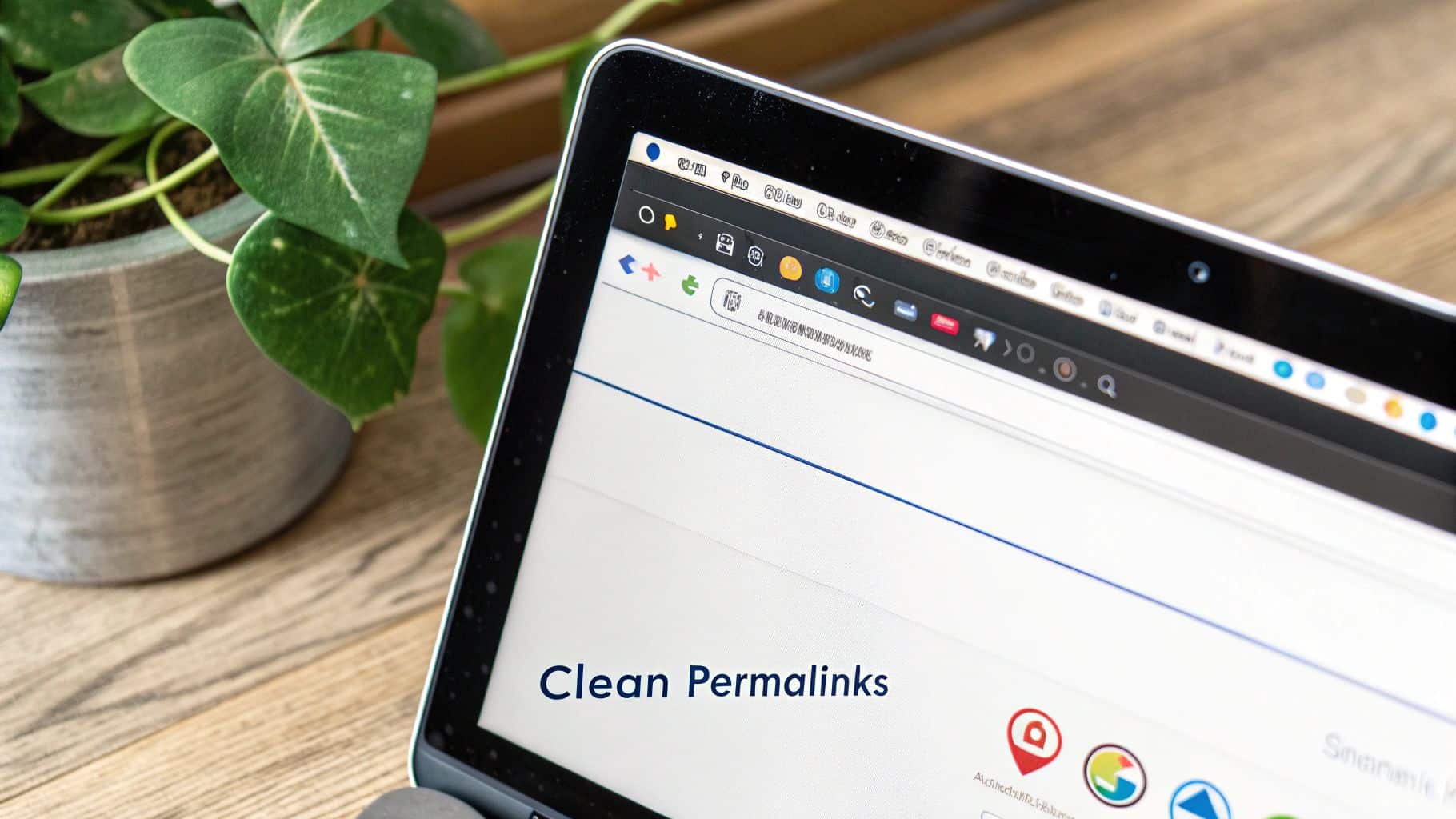
Why This Is a Foundational Step
Clean URLs are a ranking factor. Major sites meticulously craft their URL structures to reflect their content hierarchy and target keywords. For example, HubSpot uses a /blog/category/post-name structure to organize its vast library of marketing content, while Moz often uses a simple /blog/post-name format. These structures provide context and improve keyword relevance directly in the search results, which can enhance click-through rates.
Key Insight: A well-optimized permalink acts as its own mini-summary. It tells users and search engines exactly what the page is about, improving clarity and trust before the page even loads.
Actionable Tips for Configuration
Configuring your permalinks is straightforward but should be done carefully, especially on an existing site. Navigate to Settings > Permalinks in your WordPress dashboard to get started.
- Choose 'Post name' for Simplicity: For most blogs and business websites, the
/%postname%/structure is the best choice. It's clean, short, and focuses on the primary keyword of the page. - Set It and Forget It: Ideally, you should set your permalink structure when you first launch your website. Changing it later on an established site requires setting up 301 redirects from the old URLs to the new ones to avoid broken links and lost SEO value.
- Manually Edit Your Slugs: After writing a post, WordPress automatically generates a URL slug from your title. Always edit this slug to remove stop words (like 'a', 'the', 'in') and shorten it to focus on the core keyword.
- Use Hyphens, Not Underscores: Always use hyphens (-) to separate words in your URLs. Google's algorithm treats hyphens as word separators, while underscores are often interpreted as joining words together.
3. Implement Proper Heading Tag Hierarchy (H1-H6)
Heading tags (H1, H2, H3, etc.) are far more than just a way to make text bigger; they create a logical and hierarchical structure for your content. This structure serves as an outline that tells both search engine crawlers and human readers what your page is about and how its information is organized. Proper hierarchy is a core element of on-page SEO, improving readability, accessibility, and search engine comprehension.
In WordPress, your theme should automatically assign the main title of your post or page as the H1 tag. Your job is to use H2 through H6 tags to break down your content into logical sub-sections. This creates a clear flow, making it easier for users to scan for relevant information and for search engines to understand the relationships between different content blocks, which is a vital part of implementing WordPress SEO best practices.
Why This Is a Foundational Step
A clear heading structure acts as a roadmap for your content. For instance, Wikipedia's articles are famously easy to navigate due to their strict heading hierarchy, which automatically generates a table of contents. Similarly, long-form guides from sites like Backlinko use H2 tags for major sections and H3s for subsections, allowing readers to easily grasp the article's structure and find specific answers. Without this logical flow, your content becomes a wall of text that is difficult to parse for both users and search engines.
Key Insight: Heading tags are not for styling; they are for structure. Use them to create a semantic outline of your page, and let your theme's CSS handle the visual presentation.
Actionable Tips for Configuration
Implementing a proper heading hierarchy requires a deliberate approach within the WordPress editor:
- One H1 Per Page: Your post or page title is your H1. Never add another H1 tag within your content.
- Maintain Sequential Order: Don't skip heading levels. Always follow an H2 with an H3 for a sub-point, not an H4. Think of it like a formal outline.
- Include Keywords Naturally: Place your primary and secondary keywords in your H2 and H3 tags where it makes sense. This provides strong contextual signals to search engines.
- Make Headings Descriptive: Each heading should accurately describe the content that follows. This helps with user experience and can make your content eligible for featured snippets in search results.
- Check Your Theme's Markup: Use your browser's "Inspect" tool to verify that your theme correctly assigns the H1 to the title and styles other headings appropriately.
4. Optimize Images with Alt Text, Compression, and Proper File Names
Image optimization is a multifaceted practice that is critical for both site performance and on-page SEO. Large, unoptimized images are one of the primary causes of slow page load times, which directly impacts user experience and search engine rankings. By compressing images, using descriptive file names, and adding meaningful alt text, you enhance accessibility, improve Core Web Vitals, and create new opportunities for your content to be discovered through Google Images.
This process ensures your site is fast for users and that search engines can understand the visual content on your pages. For a WordPress SEO strategy, it’s not just about having images; it’s about making them work for you. Proper optimization turns them from simple media files into valuable SEO assets.

Why This Is a Foundational Step
Think of images as a major component of your site's performance budget. E-commerce giant Etsy saw a 12% increase in mobile conversions after optimizing product images, proving the direct link between image speed and revenue. Similarly, Pinterest reduced perceived load times by 40% through extensive image optimization, significantly boosting user engagement. These examples highlight that image SEO is a high-impact, foundational practice for any serious website.
Key Insight: Image optimization is not just a technical task; it's a user experience and accessibility requirement. It makes your site faster for everyone and understandable to both visually impaired users and search engine crawlers.
Actionable Tips for Configuration
Integrating image optimization into your workflow is simple with the right tools and habits. Use an image optimization plugin like ShortPixel or Imagify to automate compression and WebP conversion.
- Rename Files Before Uploading: Always change generic filenames. Instead of
IMG_9876.jpg, use a descriptive name likewordpress-seo-image-optimization-tips.jpg. This provides context to search engines. - Write Descriptive Alt Text: Alt text should accurately describe the image for screen readers and search crawlers. For example, use "A screenshot showing the Yoast SEO plugin's keyword analysis feature" instead of just "Yoast SEO".
- Compress and Resize: Use a plugin or a tool like TinyPNG to compress images without losing quality. Importantly, resize images to the exact dimensions needed on your site before uploading to avoid unnecessary browser scaling.
- Enable Lazy Loading: WordPress includes native lazy loading, which defers loading images below the fold until the user scrolls to them. Ensure this feature is active to improve initial page load speed.
- Use Modern Formats: Convert images to next-gen formats like WebP, which offers significantly smaller file sizes than traditional JPEGs and PNGs. Most optimization plugins handle this automatically.
5. Improve Site Speed and Core Web Vitals
Page speed is a confirmed Google ranking factor and a cornerstone of exceptional user experience. Fast-loading websites see higher engagement, lower bounce rates, and better conversion rates. Google quantifies this user experience through its Core Web Vitals: Largest Contentful Paint (LCP), First Input Delay (FID), and Cumulative Layout Shift (CLS). Optimizing these metrics is a critical aspect of modern WordPress SEO best practices, as it directly influences how Google perceives your site's quality.
Because of its dynamic nature, WordPress can be prone to performance issues without proper tuning. Optimizing your site involves a multi-faceted approach, including implementing caching, minifying code, using a Content Delivery Network (CDN), and optimizing your database. These actions reduce server load and decrease the time it takes for a browser to render your page, directly improving your Core Web Vitals scores.
The infographic below outlines the foundational workflow for dramatically improving your site's loading times.
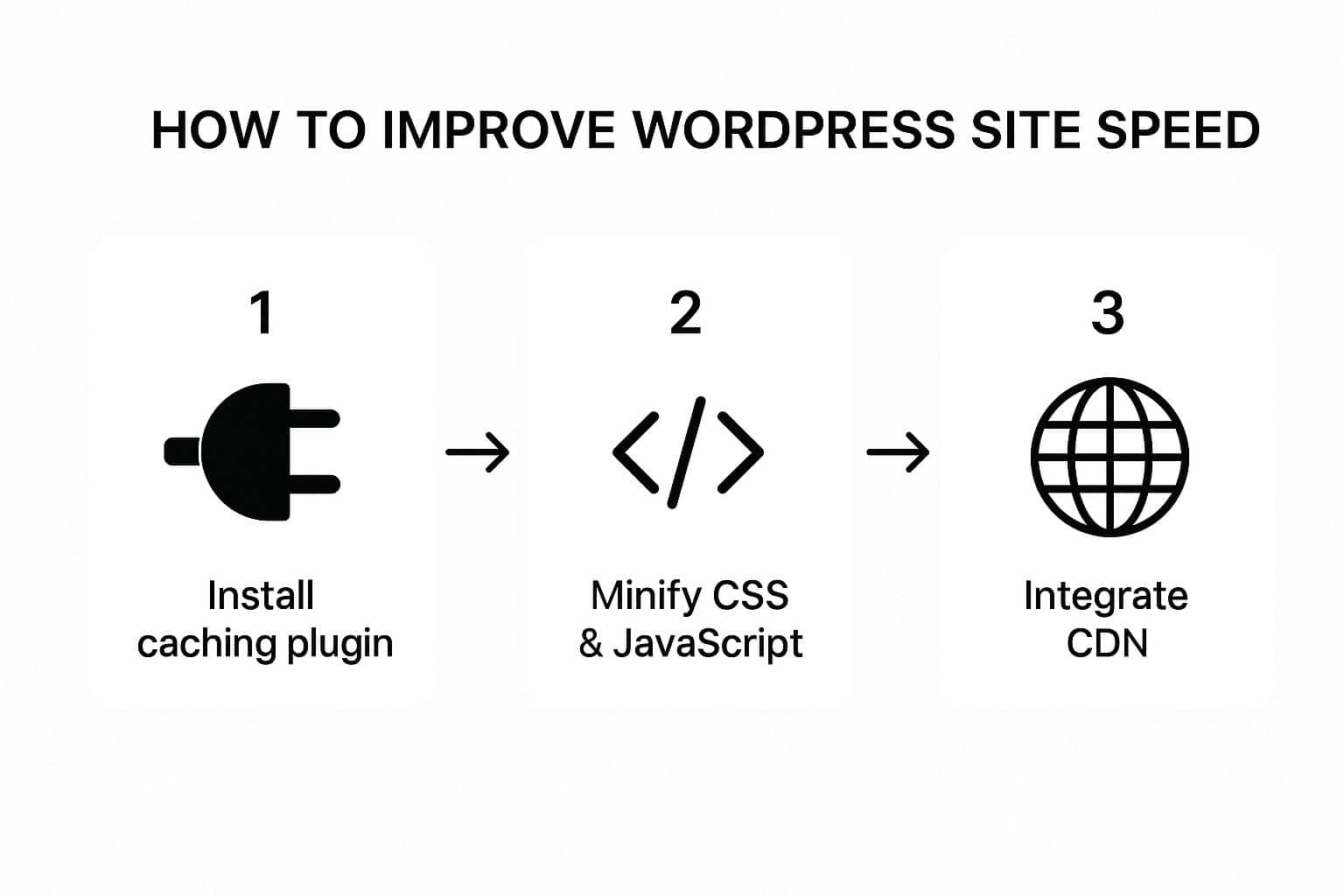
This process highlights the essential sequence of performance optimizations, starting with server-level caching and progressively enhancing content delivery.
Why This Is a Foundational Step
A slow website actively works against all your other SEO efforts. For instance, Walmart discovered that for every one-second improvement in page load time, conversions increased by 2%. Similarly, Pinterest reduced load times by 40% and saw a corresponding 15% increase in SEO traffic. These figures demonstrate that performance is not just a technical metric; it's a key driver of business growth and search visibility.
Key Insight: Optimizing for Core Web Vitals isn't just about pleasing Google's algorithm. It's about providing a superior user experience that directly translates to better engagement and higher rankings.
Actionable Tips for Configuration
To enhance your site's performance, focus on these high-impact optimizations. To dig deeper into this topic, you can learn more about easy ways to improve site speed on techgeekers.com.
- Install a Caching Plugin: Use a powerful plugin like WP Rocket, W3 Total Cache, or LiteSpeed Cache to create static HTML versions of your pages, drastically reducing server processing time.
- Implement a CDN: A Content Delivery Network like Cloudflare or BunnyCDN distributes your site’s static assets (images, CSS, JS) across a global network of servers, delivering them to users from the nearest location.
- Optimize Images: Compress images without losing quality using a plugin like ShortPixel or Imagify. Also, serve images in next-gen formats like WebP.
- Choose Quality Hosting: Your hosting environment is the foundation of your site's speed. Avoid cheap shared hosting and opt for a managed WordPress host or a quality VPS for better performance and reliability.
- Minimize Plugins and Use a Lightweight Theme: Audit your plugins and remove any that are not essential. Choose a performance-optimized theme like GeneratePress, Astra, or Kadence as your base.
- Monitor Core Web Vitals: Regularly check the Core Web Vitals report in your Google Search Console to identify and fix pages with poor user experience scores.
6. Create and Submit XML Sitemaps
An XML sitemap acts as a roadmap for search engines, listing all the important URLs on your website to ensure efficient and comprehensive crawling. While crawlers can discover pages through links, a sitemap explicitly tells them which pages you consider valuable and how they are structured. For WordPress users, this critical component of technical SEO is easily managed, as plugins like Yoast SEO and Rank Math automatically generate and update your sitemap whenever you add or modify content.
Submitting this sitemap directly to search engines like Google and Bing is a proactive way to improve indexation. It ensures that crawlers are immediately aware of new blog posts, updated pages, or new products, significantly reducing the time it takes for your content to appear in search results. This process is fundamental to any effective WordPress SEO best practices strategy, as it directly impacts how quickly and completely search engines understand your site's content.
Why This Is a Foundational Step
Think of a sitemap as an open line of communication with search engines. Large, complex sites like Amazon and CNN rely heavily on segmented sitemaps to manage millions of URLs, creating separate maps for products, articles, images, and videos. This ensures their vast content libraries are systematically discovered. Similarly, Shopify stores automatically generate product sitemaps, a crucial feature for e-commerce sites where timely product indexation directly affects sales.
Key Insight: A sitemap doesn't guarantee higher rankings, but it guarantees better and faster discoverability. By providing a clear and complete map, you remove any guesswork for search engine crawlers, ensuring your valuable content doesn't get overlooked.
Actionable Tips for Configuration
Your SEO plugin handles the creation, but proper configuration and submission are key. Follow these steps to maximize the benefits of your XML sitemap:
- Submit to Search Consoles: The most important step is to submit your sitemap URL (usually
yoursite.com/sitemap_index.xml) to both Google Search Console and Bing Webmaster Tools. This officially registers your site map with the search engines. - Add to robots.txt: Include a line in your
robots.txtfile pointing to your sitemap:Sitemap: https://yoursite.com/sitemap_index.xml. This provides another discovery point for crawlers. - Exclude Low-Value Pages: Use your SEO plugin’s settings to exclude pages you don't want indexed, such as admin login pages, thank-you pages, or thin content. A sitemap should only contain indexable, high-value URLs.
- Monitor for Errors: Regularly check the "Sitemaps" report in Google Search Console. It will alert you to any issues, such as broken links or server errors, that prevent crawlers from accessing your pages.
7. Implement Schema Markup (Structured Data)
Schema markup, or structured data, is a semantic vocabulary of code you add to your website to help search engines understand the context of your content more deeply. For WordPress users, this means going beyond just telling Google that you have a blog post; you can specify that it's a recipe, a product review, a news article, or an FAQ page. This enhanced understanding allows search engines to display your content as "rich results" or "rich snippets" in the SERPs, which can dramatically improve visibility and click-through rates.
Instead of just a standard blue link, schema can enable search results to show star ratings, cooking times, event dates, or product prices directly on the results page. This provides a significant competitive advantage by making your listing more informative and visually appealing than others. It's a key tactic in modern WordPress SEO best practices for standing out in crowded search results.
Why This Is a Foundational Step
Think of schema markup as translating your webpage's content into a language that search engine bots understand fluently. High-authority sites like IMDb use it to show movie ratings and cast lists, while AllRecipes uses Recipe schema to display prep times and calorie counts, capturing user attention before they even click. This direct communication with search engines helps them categorize and feature your content accurately, which is essential for E-E-A-T (Experience, Expertise, Authoritativeness, Trustworthiness) signals.
Key Insight: Schema markup doesn't directly influence your rankings, but the rich results it generates can significantly increase your CTR. A higher CTR can be a positive ranking signal, indirectly improving your search performance.
Actionable Tips for Configuration
Modern SEO plugins have made implementing schema markup on WordPress easier than ever. You don't need to be a developer to leverage this powerful technique.
- Use Your SEO Plugin: Both Rank Math (free) and Yoast SEO (premium) offer robust schema features. You can set a default schema type (e.g., Article for your blog) and then customize it for individual pages or posts like FAQs, How-to guides, or Reviews.
- Validate Your Markup: After implementing schema, always use Google’s Rich Results Test tool. This will show you if your markup is valid and whether the page is eligible for rich results.
- Be Specific and Honest: Use the most specific schema type that applies to your content (e.g.,
Recipeinstead of justCreativeWork). Importantly, never mark up content that isn't visible to users or use fake reviews, as this violates Google's guidelines and can lead to a penalty. - Implement Key Schema Types: Start with
Articleschema for all posts,FAQPagefor Q&A sections,Reviewfor reviews (includingAggregateRating), andOrganizationorPersonschema to strengthen your E-E-A-T profile.
8. Optimize Content with Focus Keywords and Internal Linking
Beyond simply writing content, true on-page optimization involves a dual strategy: precisely targeting focus keywords and weaving a strong internal linking web. This practice is central to effective WordPress SEO best practices, as it tells search engines exactly what your content is about while simultaneously demonstrating its relationship to other pages on your site. By strategically placing keywords and creating contextual links, you guide both users and search crawlers through your site, improving topical authority and distributing link equity.
This combination of keyword optimization and internal linking forms the backbone of your content architecture. It signals to Google which pages are most important (your cornerstone content) and helps it discover and index deeper pages more efficiently. A well-executed strategy turns individual blog posts into a cohesive, interconnected library of information, significantly boosting your site's overall SEO performance.
Why This Is a Foundational Step
This is how content earns its rankings. Industry leaders like Backlinko and HubSpot have built their authority using this model. Backlinko's "Skyscraper Technique" relies on targeting a specific keyword and building comprehensive content, while HubSpot popularized the "topic cluster" model, where a central "pillar" page is internally linked to and from numerous related "cluster" articles. Wikipedia's immense authority is a testament to the power of a dense, relevant internal linking structure.
Key Insight: Focus keywords get your content noticed by search engines, but a strong internal linking structure is what establishes its authority and context within your website's ecosystem. One without the other is an incomplete strategy.
Actionable Tips for Configuration
Integrate these optimization techniques directly into your content creation workflow within WordPress:
- Strategic Keyword Placement: Place your primary focus keyword within the first 100 words of your article, in your main H1 title, and in at least one subheading (H2, H3). Use your SEO plugin's analysis tool as a guide, but always prioritize natural readability.
- Use Descriptive Anchor Text: When creating internal links, use descriptive anchor text that includes keywords relevant to the linked page. Avoid generic phrases like "click here" or "read more," as this provides no contextual value to search engines.
- Build Content Clusters: Identify a core topic for your business and create a long-form "pillar page." Then, write multiple, more specific articles that link back to that pillar page and to each other. This is a powerful way to demonstrate topical expertise.
- Link Deep, Not Shallow: Prioritize linking to specific, relevant blog posts and pages deep within your site's structure rather than repeatedly linking back to your homepage or contact page.
- Update Old Content: Regularly revisit older posts to add internal links to your newer, relevant articles. This passes authority to your new content and keeps your older content fresh and interconnected.
9. Ensure Mobile Responsiveness and Mobile-First Design
Ensuring your WordPress site is mobile-responsive is no longer an option; it's a fundamental requirement for modern SEO. This means your website's layout, images, and navigation must fluidly adapt to provide an optimal experience on any device, from a large desktop monitor to a small smartphone. Since Google's shift to mobile-first indexing, the mobile version of your site is the primary one used for ranking and indexing. If your site is clunky, slow, or difficult to use on a phone, your search visibility will suffer significantly.
A mobile-first approach prioritizes the user experience on the smallest screens, ensuring that core content and functionality are accessible and efficient. This focus translates directly into better engagement, lower bounce rates, and improved search engine rankings, making it a cornerstone of any effective WordPress SEO strategy.
Why This Is a Foundational Step
Think of mobile responsiveness as the price of admission to the modern internet. A poor mobile experience is a direct signal to Google that your site offers a subpar user experience. Major brands have seen massive returns from this focus; for example, The Guardian's responsive redesign led to a 44% improvement in mobile engagement, while Starbucks doubled its rate of mobile orders after launching a mobile-first site. These examples show a direct correlation between mobile usability and achieving business goals.
Key Insight: Mobile-first indexing means Google primarily uses your mobile site to understand and rank your content. An unoptimized mobile experience is equivalent to submitting a broken website to Google for evaluation.
Actionable Tips for Configuration
Implementing a mobile-first design is a strategic choice that starts with your theme and continues with ongoing testing. Here’s how to ensure your WordPress site excels on mobile:
- Choose a Responsive Theme: Start with a WordPress theme that is explicitly advertised as "responsive" or "mobile-first." Reputable theme marketplaces like Themeforest or the official WordPress repository are excellent places to find one.
- Test with Google's Tools: Regularly use Google’s free Mobile-Friendly Test tool to analyze your pages. Also, monitor the "Mobile Usability" report in Google Search Console for any reported issues.
- Prioritize Readability and Touch: Ensure your body text font size is at least 16px to prevent users from needing to pinch-to-zoom. All tappable elements, like buttons and links, should have a minimum target size of 48×48 pixels.
- Optimize Mobile Performance: Mobile page speed is critical. Use a performance plugin like WP Rocket, optimize your images with a tool like ShortPixel, and consider a Content Delivery Network (CDN) to ensure fast load times for mobile users on cellular networks.
10. Maintain Security with HTTPS and Regular Updates
Website security is a frequently overlooked yet critical component of WordPress SEO best practices. Google has confirmed that HTTPS is a ranking signal, and browsers like Chrome and Firefox actively flag non-HTTPS sites as "Not Secure," which severely erodes user trust and can increase bounce rates. This encryption protects data transferred between a user's browser and your server, building a foundation of credibility that search engines and visitors reward.
Beyond encryption, the ongoing maintenance of your WordPress installation is paramount. Regular updates to the WordPress core, themes, and plugins patch security vulnerabilities that hackers could exploit. A compromised site can lead to malware, spam injections, or complete de-indexing by Google, which can take months to recover from. Thus, strong security directly protects your SEO rankings, uptime, and brand reputation.
Why This Is a Foundational Step
Security isn't just about preventing attacks; it's about maintaining a stable, trustworthy online presence that search engines feel confident sending users to. When Patagonia migrated to HTTPS, they maintained their traffic while strengthening user trust signals. In contrast, major security breaches, like the one that led to a £20 million fine for British Airways, can devastate both brand reputation and search visibility. A secure site is a reliable site, which is a core tenet of good SEO.
Key Insight: Security and SEO are deeply intertwined. A secure website is fast, reliable, and trustworthy, which are all positive signals for Google's algorithms. Neglecting security is like building a house on unstable ground; it’s only a matter of time before everything collapses.
Actionable Tips for Configuration
Implementing strong security measures is a continuous process, not a one-time task. Here are the essential steps to protect your WordPress site:
- Install an SSL Certificate: Most modern web hosts offer a free SSL certificate from Let's Encrypt. Activate it and use a plugin like Really Simple SSL to automatically configure your site to use HTTPS.
- Update Everything Consistently: Enable automatic updates for the WordPress core. Set a recurring monthly task to review and update your plugins and themes. Remove any unused plugins or themes, as they are common security risks.
- Harden Your Login: Change the default 'admin' username, use a strong and unique password, and enable two-factor authentication (2FA). Install a security plugin like Wordfence or Sucuri to limit login attempts and scan for malware. You can review a more comprehensive cybersecurity checklist on techgeekers.com for advanced hardening techniques.
- Monitor and Back Up: Regularly check the "Security Issues" report in Google Search Console for any warnings. Ensure you have an automated backup solution in place so you can quickly restore your site if a problem occurs.
WordPress SEO Best Practices Comparison
| Item | Implementation Complexity 🔄 | Resource Requirements ⚡ | Expected Outcomes 📊 | Ideal Use Cases 💡 | Key Advantages ⭐ |
|---|---|---|---|---|---|
| Install and Configure an SEO Plugin (Yoast SEO or Rank Math) | Moderate – Plugin installation and configuration; learning curve for advanced features | Low to Moderate – Plugin usage, occasional premium features | Improved SEO management, automated technical SEO, content optimization guidance | Websites needing comprehensive SEO tools without deep technical knowledge | Simplifies SEO tasks, automates sitemaps, content analysis, regularly updated |
| Optimize Permalink Structure for SEO | Low – Set once carefully in WordPress settings | Minimal – Just configuration changes | Cleaner URLs, better click-through rates, improved SEO relevance | New sites or sites preparing for SEO-friendly URLs | Enhances URL readability, improves ranking signals, supports UX |
| Implement Proper Heading Tag Hierarchy (H1-H6) | Low to Moderate – Requires content planning | Minimal – Just editing headings in content | Better content structure and accessibility, enhanced SEO signals | Content-heavy sites and blogs needing clear organization | Improves scannability, accessibility, supports featured snippets |
| Optimize Images with Alt Text, Compression, and Proper File Names | Moderate – Requires workflow integration | Moderate – Tools for compression and naming | Faster load times, accessibility improvements, higher image search traffic | Media-rich sites, e-commerce, blogs with many images | Improves page speed, accessibility, mobile experience, reduces bandwidth |
| Improve Site Speed and Core Web Vitals | High – Involves caching, minification, CDN setup, optimization | Moderate to High – Premium plugins, CDN services | Higher rankings, better user engagement, reduced bounce rates | All sites prioritizing SEO and user experience improvements | Direct ranking impact, better UX, lower server costs |
| Create and Submit XML Sitemaps | Low – Often automated via plugins | Low – Plugin generation and submission | Faster content discovery and indexation, improved crawl efficiency | Large or frequently updated sites | Simplifies indexing, signals content priority, supports media indexing |
| Implement Schema Markup (Structured Data) | Moderate to High – Requires technical setup or plugin | Moderate – Plugins or manual implementation | Rich snippets, better search visibility, enhanced CTR | Content-rich sites with structured data like reviews, recipes | Increases visibility, supports voice search, boosts CTR |
| Optimize Content with Focus Keywords and Internal Linking | Moderate – Ongoing content strategy and optimization | Moderate – SEO tools and keyword research | Improved relevance, better crawlability, increased user engagement | Blogs, resource centers, and sites building topical authority | Builds site authority, improves user navigation, enhances SEO signals |
| Ensure Mobile Responsiveness and Mobile-First Design | Moderate to High – Requires responsive theme and testing | Moderate – Responsive themes and testing tools | Improved rankings, better user experience on mobile devices | All modern websites, especially with high mobile traffic | Required for mobile-first indexing, reduces bounce, enhances conversions |
| Maintain Security with HTTPS and Regular Updates | Moderate – SSL setup and ongoing maintenance | Low to Moderate – SSL certificates, security plugins | Improved rankings, user trust, protection from penalties and hacks | All websites prioritizing security and SEO | Ranking factor, builds trust, prevents malware and de-indexing |
Turning Best Practices into Consistent Results
You've just navigated a comprehensive roadmap of the most impactful WordPress SEO best practices, moving from foundational setups like SEO plugins and permalink structures to critical performance optimizations like site speed and mobile responsiveness. We've detailed the importance of on-page elements such as heading hierarchies and image alt text, and dived into the technical essentials of XML sitemaps, schema markup, and site security. Each of these ten pillars, from content strategy to Core Web Vitals, represents a crucial lever you can pull to enhance your site's visibility and authority in the eyes of search engines.
However, the true power of this knowledge isn't in just understanding these concepts; it's in their consistent and integrated application. Viewing SEO as a "set it and forget it" task is a common pitfall. Instead, you must treat it as an ongoing, iterative process. Your permalink structure might be set once, but your internal linking strategy will evolve with every new piece of content you publish. Your initial site speed optimizations are great, but new plugins or theme updates can introduce performance bottlenecks that require continuous monitoring.
From Checklist to Habit: Your Actionable SEO Workflow
To transform this list from a one-time checklist into a sustainable growth engine, you need to build a routine. Think of it less as a project and more as a fundamental part of your digital operations. Here are the immediate next steps to translate these principles into tangible results:
- Conduct a Self-Audit: Use this article as your guide. Go through your WordPress dashboard and a tool like Google Search Console to systematically review each of the ten areas. Where are the biggest gaps? Low-hanging fruit, like missing alt text on key pages or an unsubmitted sitemap, can often yield quick wins.
- Prioritize with Impact in Mind: You don't have to tackle everything at once. If your site speed is critically slow (as reported by PageSpeed Insights), that should be your top priority, as it impacts user experience and rankings directly. Conversely, if your on-page SEO is solid, perhaps your next focus should be implementing basic schema markup to enhance your SERP appearance.
- Create a Content and Technical SEO Calendar: Schedule regular check-ins. Dedicate one day a month to a "Technical SEO Health Check," where you review Core Web Vitals, check for broken links, and ensure your plugins and theme are updated. Similarly, make keyword optimization and internal linking a non-negotiable step in your content publishing workflow.
Mastering these WordPress SEO best practices is ultimately about building a resilient, high-quality digital asset. A well-optimized site doesn't just rank higher; it provides a better, faster, and more secure experience for your visitors. This focus on user experience is precisely what search engines like Google aim to reward. By committing to these principles, you are future-proofing your website against algorithm updates and building a powerful, sustainable channel for organic traffic that will pay dividends for years to come. The effort you invest today is the foundation for tomorrow's growth.
Ready to dive deeper and master the technical side of your digital presence? Tech Geekers offers in-depth guides, expert tutorials, and actionable insights on everything from advanced WordPress configurations to cybersecurity and hosting optimization. Visit Tech Geekers to access the resources you need to turn your website into a high-performance machine.
Article created using Outrank

